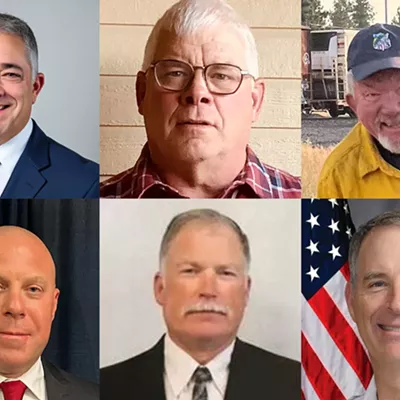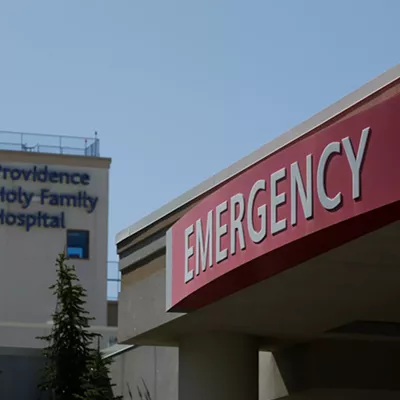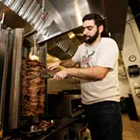Early in the 1890s, German immigrant Franz Pietsch bought a small lot in the newly-platted residential area now known as Peaceful Valley and built a tidy brick home for his family. Pietsch and his wife, Augusta, had come to the United States a few years before and settled in the upper Midwest. Following Spokane's disastrous fire in 1889, massive rebuilding efforts opened opportunities for laborers in the building trades. At the same time, the railroads recruited immigrants to come to the burgeoning Inland Empire for land and jobs. Pietsch, who worked as a stonemason and bricklayer, found his trade much in demand in the emerging city of Spokane, so the family came west in a time-honored quest for a better life.
Franz Pietsch's two-and-a-half story Italianate-inspired house at 1647 West Main Avenue still stands, not only as a landmark for Peaceful Valley but as a living testament to the history of the working men and women who literally built Spokane. The Pietsch house was one of the primary reasons for the neighborhood's designation as a National Historic District, because of its significance "as a rare and intact example of a working-class neighborhood dating from the turn of the century." The Pietsch house is also the first stop on the 14th annual Mother's Day Historic Neighborhood Tour, scheduled for this weekend. Presented by the Historic Preservation Committee of the Northwest Museum of Arts & amp; Culture, this year's tour features four private homes in Peaceful Valley and three in Browne's Addition, along with the MAC's Campbell House.
The two neighboring historic districts provide a contrast in styles and stories, although the featured homes all date from the same general time period. While Browne's Addition was one of Spokane's earliest upscale residential areas, Peaceful Valley housed families of much more modest means who, like the Pietsches, built their own homes. Yet according to historian Nancy Gale Compau of the Northwest Room at Spokane Public Library, it's not true that the servants of Browne's Addition families lived in the valley below. Servants instead lived in the homes of their employers. Peaceful Valley was largely a neighborhood of working immigrants (most from Finland, Germany, or Sweden, although the valley also attracted Italians and African-Americans).
"Many Peaceful Valley residents worked in the building trades," she explains. "They were the stonemasons, carpenters, mill workers, lumberjacks, teamsters, and laborers who poured their sweat into long hours at low pay to construct and maintain Spokane."
That kind of working-class heritage has only recently been recognized as worthy of preservation -- which is one of the reasons the neighborhood was selected for the tour.
"There's a wonderful assortment of houses this year because of the two very different neighborhoods," says Patti Larkin, curator of the Campbell House at the MAC. "The homes in Browne's Addition are large, all pre-1900, and with a lot of decorative elements, especially of the Queen Anne style. In Peaceful Valley, the homes are considerably smaller, and they tended to be built by the people who lived there."
The laborers who built their homes in Peaceful Valley also built the grand homes and businesses of the more well-to-do residents of the city. For instance, Louis Pietsch, son of Franz, helped construct the Great Northern Railroad clock tower, the Davenport Hotel, and the hospital at Medical Lake, among other prominent structures. The Finnish members of the community built a social hall and several steam baths, and residents lobbied for the construction of the Cowley School to save their children the steep climb up the hill to Browne's Addition.
As home to many laborers, Peaceful Valley was also home to early labor union activists, including members of the IWW (Industrial Workers of the World). A 1917 IWW strike against the lumber industry came to a close when the strikers met at the Finnish social hall in Peaceful Valley and voted to end their walk-out.
The Mother's Day Historic Neighborhood Tour includes the first-floor interiors of seven homes; no food, drink, smoking, photographs, backpacks, spiked heels, or strollers are allowed inside the tour homes. Ticket holders may also tour the Campbell House at no additional charge. Parking is available at the MAC (2316 W. First Ave.) and the Peaceful Valley Community Center (214 N. Cedar St.). A free STA streetcar will make continual loops between the two neighborhoods, stopping at parking locations and open houses.
The tour runs from noon-4 pm on Saturday and Sunday, May 10-11. Tickets cost $10 per person and are on sale now at the MAC. On the days of the tour, tickets may also be purchased either at the Pietsch House, 1647 W. Main Ave., or at the MAC.
Publication date: 05/08/03














